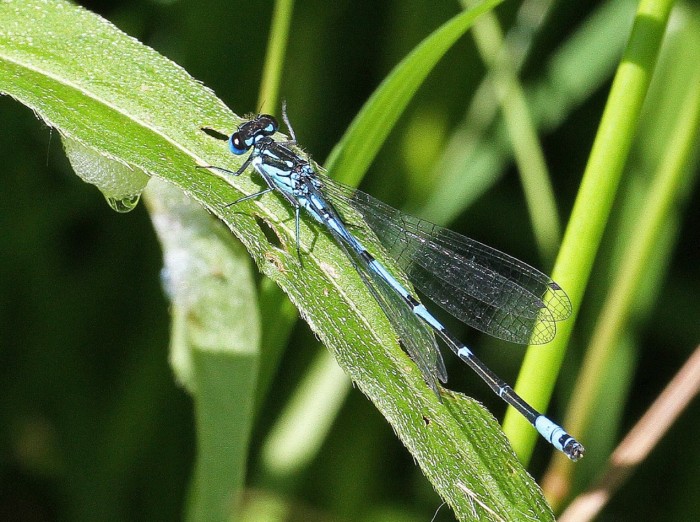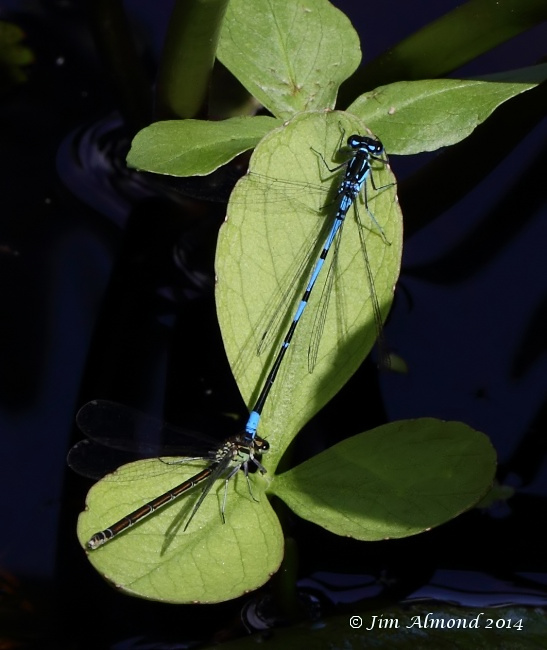Name
Coenagrion pulchellum (Vander Linden, 1825)
Family:
Coenagrionidae
Status in Britain and Ireland:
scarce and local
Near Threatened (GB Red List)
Local Status:
rare
Size:
Overall body length 34-38mm
Hindwing length 16-23mm
Flight period:
Mid May until mid August
Photograph © M. Foley
Male Variable Damselfly
The body is blue with black markings. The narrow blue antehumeral stripes present on the thorax are usually broken giving the appearance of exclamation marks. On the side of the thorax are 2 narrow black lines. The top line is incomplete and described as a spur. On segment 2 there is a black goblet shape, the stem of which connects to the black ring at the end of the segment. On segment 9 there is a black shape described loosely as a bat shape that occupies more than half of the segment. Legs are black and wings are clear. A pale bar is present between the eye spots. The male is described as dracula with fangs dripping blood (antehumeral stripes) into a goblet below (segment 2) and a bat shape (segment 9).
Female green form. Photograph © B. Kemp
Female Variable Damselfly
There are 2 female forms, a green form and a blue form. The green form is almost completely black with a black thistle head pattern on segment 2. The blue form has blue markings on segments 3-7 and a black Mercury mark on segment 2.The narrow blue antehumeral stripes on the thorax are usually complete. A pale bar is present between the eye spots.
Similar Species
As the name suggests the colour pattern can be very variable. In Shropshire this species can easily be confused with Common Blue Damselfly and Azure Damselfly so careful examination is necessary.
Male Common Blue Damselflies have a ‘lollipop’ shape on segment 2, no spur on the side of the thorax, far broader antehumeral stripes and solid blue segments 8 and 9 with no black bat shape. Male Azure Damselflies have a U shape on segment 2, a black bowtie shape on segment 9 and unbroken antehumeral stripes. They have no pale bar present between the eye spots. On close inspection the trailing edge of the pronotum is more deeply lobed in Variable Damselfly.
Female Common Blue Damselflies have a spine present below segment 8 which is absent in Variable Damselfly. They also lack a spur on the side of the thorax. Female Azure Damselflies do not have a pale bar present between the eye spots and are most reliably distinguished from Variable Damselfly by close inspection of the trailing edge of the pronotum. This is more deeply lobed in the Variable Damselfly.
Behaviour
Mature males can be found amongst waterside vegetation on a suitable perch from where they fly out to capture insects and wait for females. Females only come to the water to mate spending most of their time amongst vegetation away from the water. After copulation the pair oviposit in tandem. Eggs are laid in the underside of floating vegetation such as pondweed and water lilies. The female may submerge below the water to reach suitable plant material for oviposition.
Habitat
Found in marshes, ponds, lakes, canals and slow flowing ditches with shelter and waterside vegetation.
Shropshire Distribution
Variable Damselfly has been recorded at a number of the meres over the years including Fenemere (1994), Blake Mere (1979), White Mere (1979) and Betton Pool (1980). The dates given however are the last records from these sites and even Bomere has not had a recorded sighting since 2003. Currently the majority of records come from Berrington Pool and Shomere. These 2 private sites both have adult and exuvial records. Whixall Moss is also of interest with sporadic records in 1932, 1950, 1980, a number of records in 93 and 95 and then no recorded sightings until 2012. Sporadic records also exist at Telford Town Park in 1983 and 2009 and a further record was made nearby in 1983 at Wide waters.
Where to see in Shropshire
The majority of sites mentioned are privately owned. Whixall Moss is an exception and is a great site to visit and view a good number of other species too. There is a high chance Variable Damselfly is present in a number of sites across Shropshire, but remains under recorded due to it’s similarity in appearance to other very common blue damselfly species.




